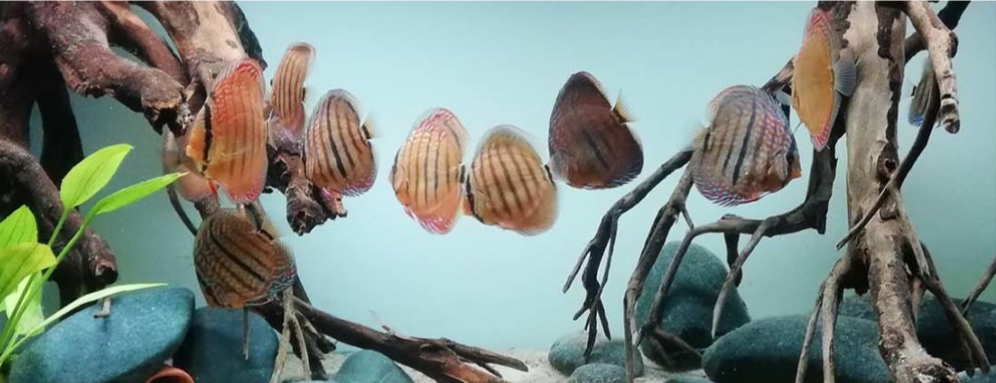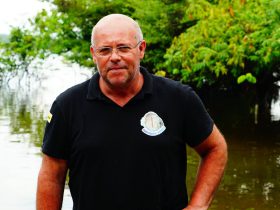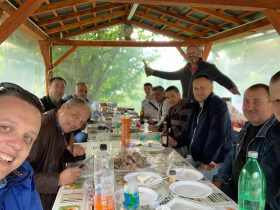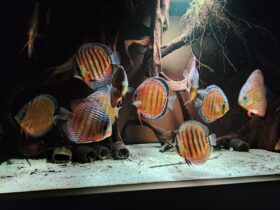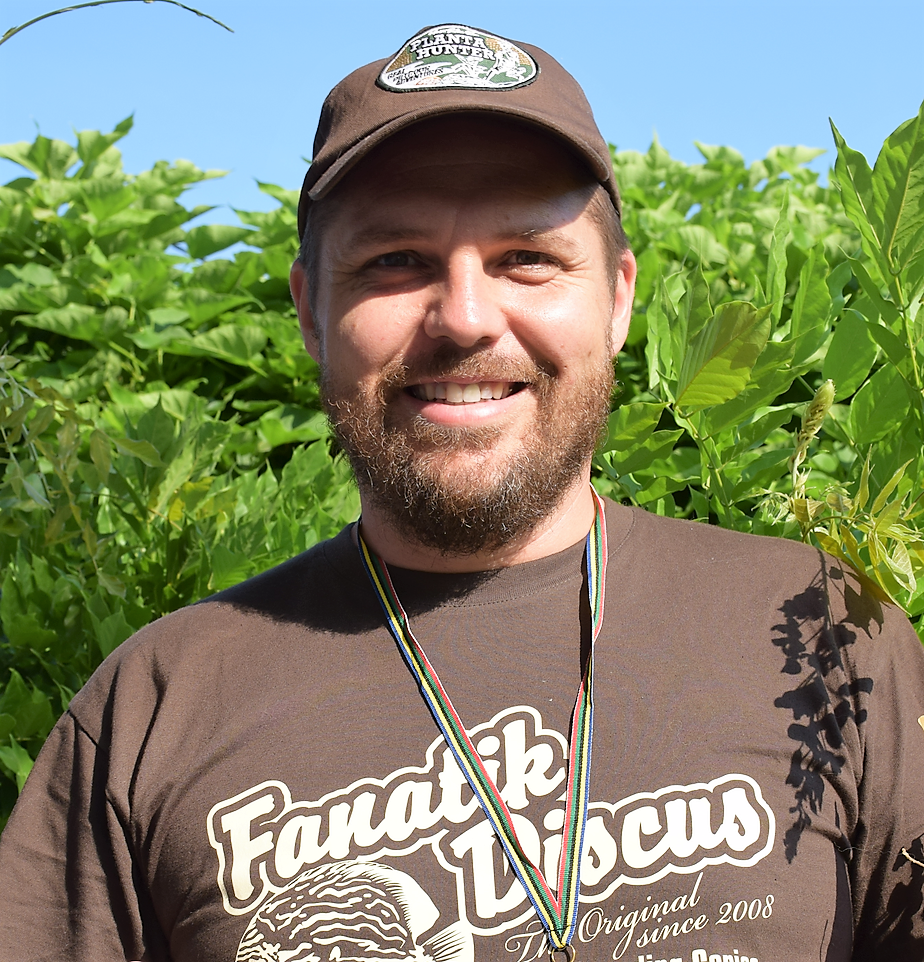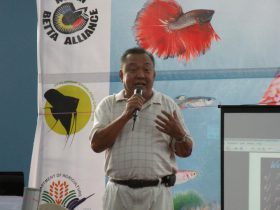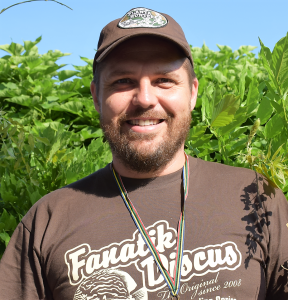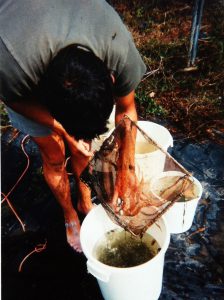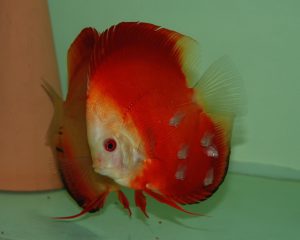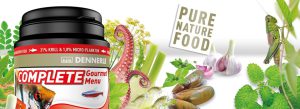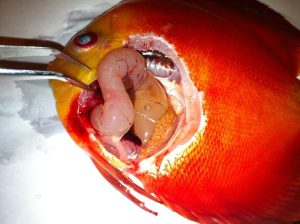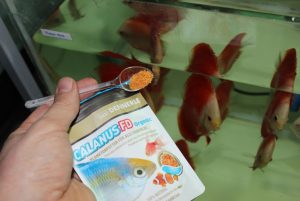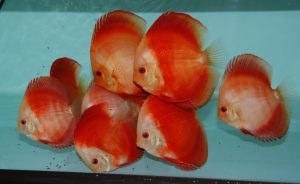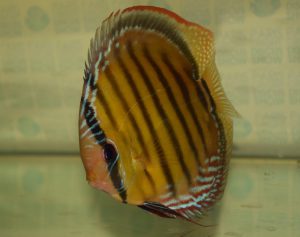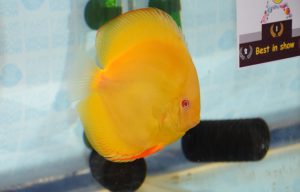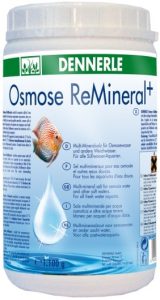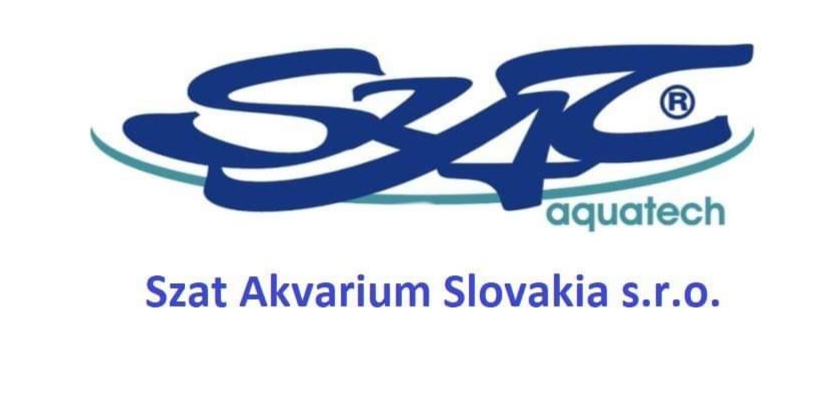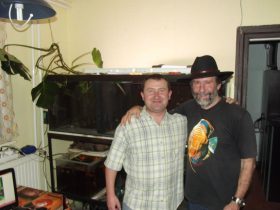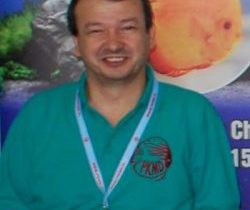Hello Mr.Hoiret,
– can you introduce yourself to members of Diskusari
My name is Yann Hoiret; I live in France. I’m fond of discus since I’m a child. My parents would say I had my bed and all discus aquariums around it! I will never stop thanking them to give me the chance to enjoy my passion.I follow the discus world news since the first Discus show in Duisburg. I discovered discus breeding with Jack Wattley book.
 In 2006, I met the “discus pope” Jack Wattley and asked him to dedicate my first discus book.
In 2006, I met the “discus pope” Jack Wattley and asked him to dedicate my first discus book.
I’ve studied 6 years in 3 different Aquaculture schools in France. This allowed me to work in several fish farms and discover many techniques. I also met many passionate persons who believed that their work was « a way of life ».
I worked in tropical fish farms, breeding as professional angel fishes, Discus, Corydoras, Trichogaster, Ancistrus etc.
Now I work in a pet shop center as a manager in France with many kinds of animals, and we were for example one of first to import in France great discus from renowned breeders.
I’m also a discus breeder and I really enjoy genetic. I breed for hobby at home and I’m specialized in red discus varieties. I built my own tiny fish farm.
My wife said that I am a fanatic, and that is why I created the website Fanatik-Discus.com where I write articles, reports about our favorite fish.
Since 2014 I started writing for some French and German magazines. Now I regularly join discus shows for judging as it was the case for French, Greek or Spanish shows.
– Composition of Dennerle food is very good, we see some new ingredients: krill, calanus, insects, algae, is it some revolution in fish diet?
I don’t know if we can say that this food is a revolution. But for sure, this is the first time I notice such quality ingredients, such reflection and willingness to propose high quality fish food available for hobbyists.
I already knew some food with one or two specific ingredients; but Dennerle fish food is different. Every ingredient is selected with care. Each composant is introduced for a specific reason. For exemple, doing a food with insects is not enough to provide good nutritional intake. The real value is the whole balanced composition. In the range, you can find several kinds of algaes, and this is quite rare in a fish food. For exemple, in the “Color Booster”, you can find Spirulina, Chlorella, Nannochloropsis and red algae.
I really appreciate the open source philosophy with the entire detailed list of ingredients introduced in the fabrication process; with no “byproducts”. Furthermore, they are no flavors additives or added preservatives. Due to the absence of artificial flavors, turning your fishes to a more natural food can take some time. But generally this doesn’t really cause problems.
I have to admit that level of reflections led by Dennerle team impressed me and results of my tests quickly convinced me to use it now.
Wrong alimentation can cause intestinal troubles. (Here occlusion)
– New thing is adding a probiotic and prebiotics why that is important and which benefit they bring?
This is true, Dennerle add prebiotics and probiotics in its range. Except in Diskus Soft that don’t have the probiotics. This because today we cannot combine probiotic bacteria and soft food. They are not long-term stable due to humidity of the soft granulate.
I would complete this with Betaglucans. More than propose quality and balanced ingredients, Dennerle also include prébiotics, probiotics and Beta-glucans in the same tropical fish food. This is very interesting for our fishes and I call this “The triple action”.
Today, several scientific studies prove the benefits of those three elements.
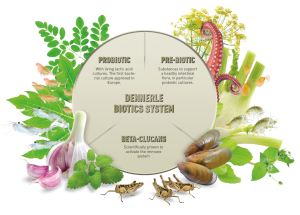 -> Probiotics are live beneficial bacteria that bring a better immunity, increase the digestibility of food, leading to lower water pollution and better grow rates.
-> Probiotics are live beneficial bacteria that bring a better immunity, increase the digestibility of food, leading to lower water pollution and better grow rates.
-> Prebiotics are substances helping the development of the intestinal microbiota which is very important for nutriments assimilation. At this moment, Dennerle use the Pediococcus acidilactici probiotic bacterium.
-> Beta-glucans adjunction leads for their part to a quicker and more efficient reaction against pathogens.
– Other new thing is soft granules (why is that important for discus fish)?
Creating a soft granulate is not an easy job. This requires special and protected techniques. Many discus enthusiasts feed their discus with frozen mixed foods. Those mixes are very palatable and if they had to choose, discus would automatically go on the frozen source.
Soft granules have a more similar consistence as natural prey like insect larvae or crustaceans. The acceptance is generally higher.
If you want to turn your discus on granulates which create less water pollution, are more balanced and easy to use; a soft granulate could be a good solution.
For sure this could take some times, but with some techniques everybody can do it. The goal is not to totally stop fresh or frozen foods, but to have a better balance between these two sources of food.
– In the past, every food for discus was based on 45-60% proteins. Now we see Dennerle lower. Are there some reasons for that?
Yes, this is for technical reason.
As you notice the Dennerle Diskus granulate is soft. Before being in a soft form granulates are dry with a 50% amount of proteins. After the soft process, and due to calculation method for the declaration, the protein amount down. The official declaration means 35% of proteins in 100 % of whole food. (Hydratation and natural plant extracts adjunction included). So the amount of proteins in this soft Dennerle food is the same as in dry forms.
Moreover, if proteins amount need is important and linked to each fish species requirements; it is very important to provide quality proteins profil. You can easily manufacture a high level protein food, but made with no digestible forms, it is not really gainful for our fishes…
Each protein source has its own amino acid profil. It is very important to provide the good sources in quality and quantity.
– Calanus Fd, can you tell us some details about this food, is it good for raising a fry?
The Dennerle Calanus FD is made of 100% Calanus finmarchicus. It is a 2-3 mm copepod zooplankton from ocean and rich in proteins (59%), amino acids, Omega 3 unsaturated fatty acids and natural carotenoids.
The Freeze Drying (FD) process or lyophilisation guaranty the quality of nutrients and flavor. And this better than frozen foods.
My fish waiting for Dennerle FD Calanus
Due to its size, we generally use it for fry once a day for a last meal. This food float and sometimes it is not easy for discus to learn eating this crustacean. Some years ago I learned a technique from Dennerle technicians I share on my Fanatik-Discus website. This allows the Calanus FD to sink and learn faster the fish to eat this new food. (http://www.fanatik-discus.fr/2014/11/calanus-fd-organic-dennerle-nourriture-discus/)
Something I like with FD plankton food is the possibility to add medicines in it. If needed this dry and very palatable food can absorb many liquids.
Last but not least, Calanus is a very clean food coming from artic waters, free of harmful substances like for example heavy metals which is often find in FD mosquito larvae or tubifex.
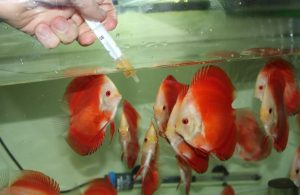 Discus learning about FD Calanus
Discus learning about FD Calanus
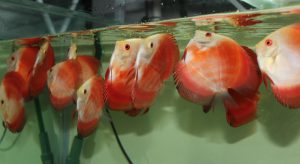 Same fishes going to surface for Dennerle FD Calanus
Same fishes going to surface for Dennerle FD Calanus
– Can you tell us how you practice the feeding of your young and big fish? How many times a day?
I manage my feeding methods according to my low free time. I’m like many of you, I breed fishes for pleasure and I have to manage this with my work…
Also, the practices I have are linked to life stage of fishes I have to care and type of food I use. The needs, the physiology for a same species are different, depending to their age.
Tiny fry will require several meals (due to its digestive evolution stage) in an easy digestible form. These first stages of life are very important and will conditionate the following grow rates. As far they can, the fry should eat live artemia nauplii. Every 2-3 hours is optimal.
At the age of 3-4 weeks old, I start to introduce very fine powder food to learn them eating dry food.
Step by step, the fishes are fed with tiny size granulates. 5-6 times a day, including a “fresh”or lyophized meal. The granulates allow me to use food distributors and this is very pleasant for someone not being at home all day long…
For adults, I fed 2-3 times a day with granulates and sometimes with fresh or lyophilized foods.
I use granulates not only because of “easy to use” reasons. It is also a very digestible food (if well chosen) that low the pollution and allow me not to change water every day. It gives harmonious grow results and not fat or bodybuilders looking fishes.
– Is it beef and turkey heart frozen mixes right food for discus fishes?
Well, this could be a long talk about this subject. We read here and there many discussions from pro and anti beef heart.
This source of food was first used for cost reasons (Bleher, 2011) and not for its nutritional quality. Some also grated it to get tiny slices that could look like red worms (Without the potential bacteria problems linked to it).
Today Beef heart is used everywhere around the world. But we have to keep in mind that goals are different from a user to another.
The beef heart is undeniably a cheap food base for discus. For some breeders installed in areas where costs of work or/and water are cheap; it is not necessary to have a reflection on which food is the best. The commercial balance between costs and turnover already lead to good results.
The digestibility of beef heart is not so good for discus and everybody will agree that it cause high water pollution. So it requires to often change large amount of water.
Also, if the Feed Conversion Rate (Feed given/Fish weight gain) of your food is not good, you will have to give more quantity and more often food to get results you want.
The questions are: What is the impact on life expectancy of our fishes? What is the impact on their immunity? On their fecundity? Etc.
I have no scientific searches to show, but my experience, my observations and the history lead me to forget this source of food that is not optimal for discus.
Discus eat beef heart without any problems. According to context it is sometimes more profitable to go in this direction. But if you look for quality approach, better will be to propose a varied diet to your fishes based on quality granulates.
– How to habituate discus fish to accept new kind of food?
The first weaning discus will have in its life will be the transfer of parental mucus to artemia nauplii and some days later to another static food.
Younger the fishes are and more the transfer is a critical time.
You have to introduce the new food first in small quantity. First meals will not give good results and this is normal. The process takes several days and shouldn’t have breaks.
When I want to give a new food, I always start to give it for the first meal of the day when fishes are hungriest. Then I wait some minutes to give their usual food. This method linked the new food to the old one.
After some days, I replace one meal in the middle of the day with the new food. You must be careful with the water quality because you can have pollution due to uneaten food.
According to the old food, the process took more or less time. It takes for example more time if the old food source contains synthetic flavors and not the new one. Even if you propose a better healthy food to your fishes, they will always choose the more palatable one first. Sometimes you have to be patient.
As I always say, my children would always choose the Hamburger and the French fries versus a balanced plate… But we know which one is the best for their health!
– You judge shows in Paris, can you tell us your impressions?
It was the second edition for this French discus club. In France, there are 2 clubs organizing their show. EDA in Paris area and SODA in southwest of the country. So since 2 years now, we have a French competition every year.
I judged also for the first edition and I noticed several things that evolved. The organization was very good and fishes where welcomed with many care. I didn’t hear or saw any health problem during the competition and this is very important.
The atmosphere was very friendly between all the discus lovers with a very nice gala dinner held in a very beautiful place. There were participants coming from far like Scotland, Poland or Indonesia. A Brazilian exporter was also there.
I think the judging team was good and I was honored to join it. It is always very pleasant to be able to exchange in a constructive way between us. I felt a lot of respect between the judges.
According to quality of fishes, it was also very interesting. We were lucky to evaluate high quality discus and as a discus photographer I enjoyed taking many shots.
There were also many wilds in this competition and their quality was very good.
I was just a little bit disappointed by the number of visitors. This year organisators couldn’t manage a tropical fish market for hobbyist breeders as they did in their last edition. I think proposing this fish market in the same time of a discus show increase the interest for visitors.
But sure the number of visitors will increase over the years.
Grand Champion Paris 2017
– What is most important for judging?
If I had to give the definition of a show fish, I would say it is an addition of several criteria.
Weight of notes is usually different according to each criteria in the notation system.
I did a lecture in Paris about reflections dedicated to the “judging system”. This was the following of my articles dedicated to “Discus classification” (http://www.fanatik-discus.fr/category/identification/).
During this lecture, I presented a judging system that would separate the criteria in 2 parts: Morphological criteria and color-pattern criteria.
In my opinion, the morphological aspects should be the most important. Even if the color and pattern are excellent, the best fishes must have a good morphology.
– Is it better to use medicated food or put medications in water, and why?
Before using any drugs, I hardly advise to check all the environmental aspects (water parameters), food they received and which stress animals could suffer. Because fishes (and animals in general) become ill due to an imbalance between the pathogens, the immune system and the environment.
Give medicines without checking those points will not lead to good results.
As I presented before, the food and its quality is a very important point to have healthy fishes. It is a point often forgotten by fish lovers.
The way to use medicine will depend on illness and health stage of the fish. For internal troubles like intestinal parasites or bacteria, it is better to add the medication in the food… But generally, the sick fish stop to eat and water medication is the only way you could have.
Observation and good analysis is the key. The discus lover will have to adapt himself according to each situation.
– We all can see many people say discus adopted at tap water, what is your opinion about that?
My opinion is very simple. Physiology of the discus indicate that this fish feel better in soft water. For sure, this specie like others have a margin of tolerance.
You can raise the discus out of its margin tolerances but this will become a stress. A stress that could lead to lower life expectancy, a lower immunity and so on… These are facts.
However, we can emphasize the genetic aspect because with selection, breeders can select discus less sensitive to hard water.
Now, for the tap water utilization, I think this clearly depend on water quality you have. Water may be so different from a region to another that we cannot simply say “Tap water is good for discus”.
And not only because of the water hardness… Water is a good solvent and according to area you are its quality can be very different.
For my part, I use tap water for my fishes, but I filter it with charcoal and fine filter. And then, I mix it with a part of Reverse osmosis. I proceed like this because I adapted my technique to the needs of the discus.
Whatever water you use, I think you never have to forget the needs of the animals you take care.
– What do you think about using various buffers and elements to prepare water for discus fishes?
I think this could be a chance for some discus to be able to have those kind of products. In some area, the water quality is so bad that discus lover have no choice; if they want to keep discus, they have to use buffers.
More and more people use buffers because of the low quality of their tap water. Presence of nitrates, phosphates, silicates, pesticides and so on may require you to use those salts.
According to goals you have, you will find different buffers.
For breeding, many breeders use Preis Minerals Diskus because it improve the GH and not the KH.
In general, I prefer to advise the Osmose Remineral+ from Dennerle because it improves the KH and the GH in a balanced way. In general we found buffers that improve the KH or the GH. The Dennerle buffer improves both.
Beside those questions do you have something important to say for Croatian discus lovers?
I would like to express something very important for me. I think that discus lovers won’t have to forget that this fabulous fish allow us to meet each other.
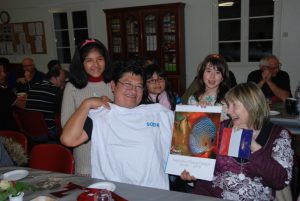 A good exemple of friendship in 2016 during the SODA France Discus Show.
A good exemple of friendship in 2016 during the SODA France Discus Show.
I think it is important to exchange and share our experiences. No matter how long you kept discus or number of fishes you have; the most important is to have the desire to progress and learn.
Also, today much information is available here and there on internet. This is a good thing but I believe that we have to support the printing press and editors. I’m quite young but I have known the development of internet and especially about discus informations. We already lost valuable websites with their informations, and I think we should not forget that paper goes through the time and stay in the history.
Thank you for accepting this interview
Thank you for this invitation. I really appreciated answering questions for your website. Really hope you will have fun with your discus.
